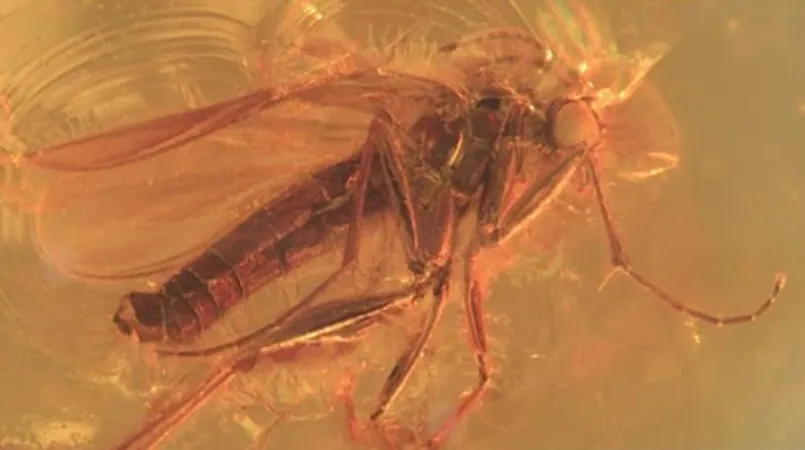
Incredible Discovery: 40-Million-Year-Old Fungus Gnat Found in Amber Revolutionizes Our Understanding of Ancient Ecosystems
2024-09-20
Incredible Discovery: 40-Million-Year-Old Fungus Gnat Found in Amber Revolutionizes Our Understanding of Ancient Ecosystems
In a remarkable turn of events, a 40-million-year-old piece of amber collected on the shores of Denmark during the 1960s has revealed a treasure trove of information about ancient insect life. Researchers from the University of Copenhagen have identified the first fossil of a predatory fungus gnat, known as ***Robsonomyia henningseni***, providing new insights into the distribution and biodiversity of these creatures during prehistoric times.
Imagine a time when Europe was teeming with warmer and more humid climates—perfect for an array of tiny winged insects, including our newly discovered gnat. This striking find allows scientists to piece together the ecological puzzle of ancient environments, shedding light on how different species interacted and adapted millions of years ago.
The fossilized gnat was discovered in what is now known as Baltic amber, which has been a vital resource for paleontologists seeking fossils due to its unique ability to preserve insects and plant material over millennia. The amber piece had lain unnoticed among the 70,000-strong collection at the Natural History Museum of Denmark. This summer, a group of Polish entomologists took a closer look, leading to the astonishing identification of this extinct species.
"Amazingly, this gnat belonged to a genus thought to exist only in Japan and North America," explains Alicja Pełczyńska, a PhD student involved in the research. "Finding it in Europe suggests that these gnats had a far wider range in ancient times than previously believed."
What's particularly intriguing is that the gnat serves as a "missing link" connecting its living cousins between continents. With thousands of kilometers separating extant species in Japan and California, the discovery fills a major gap in our understanding of fly migration patterns.
To unveil the mystery behind the amber-encased gnat, researchers conducted meticulous examinations, polishing the amber to a clear finish and using advanced imaging techniques to analyze its chemical composition. The identification relied heavily on studying unique characteristics of the male's reproductive organs, a common practice in entomology as these features are often key to distinguishing between species.
This fossil suggests that ***Robsonomyia henningseni*** thrived among the expansive pine forests of ancient Scandinavia around 35-40 million years ago. Sadly, this gnat met its end trapped in resin, which later made its way to present-day Denmark via rivers and glaciers.
The gnat was aptly named after C.V. Henningsen, the amber collector who salvaged this unique specimen. His legacy continues as this species adds to our ever-growing knowledge of insect evolution and diversity.
While scientists cannot recreate the gnat through extraction like in Jurassic Park—because much of its organic material is long gone—the amber still acts as an excellent time capsule. It allows detailed studies of the insect's structure through microCT scans, thus preserving its story for the scientific community.
Through the discovery of ***Robsonomyia henningseni***, researchers gain valuable insights into gnat migrations, contributing significantly to our understanding of biodiversity through different geological epochs. As we move forward, this finding emphasizes the importance of continued exploration of our planet's ancient past, revealing secrets locked within the depths of amber.
Fun Fact About Fungus Gnats:
The Keroplatidae family, which includes the newly discovered gnat species, is known for its captivating lifestyle. While larvae typically catch prey using sticky webs, some members of this family have even developed bioluminescent properties to lure insects. An example of this phenomenon is the famous New Zealand Glowworm, which creates an artificial 'night sky' effect inside caves.
This groundbreaking discovery not only enhances our knowledge of ecological history but also ignites curiosity about how evolutionary paths shape the diverse tapestry of life on Earth. Stay tuned for more revelations that may continue to reshape our understanding of ancient ecosystems!



 Brasil (PT)
Brasil (PT)
 Canada (EN)
Canada (EN)
 Chile (ES)
Chile (ES)
 España (ES)
España (ES)
 France (FR)
France (FR)
 Hong Kong (EN)
Hong Kong (EN)
 Italia (IT)
Italia (IT)
 日本 (JA)
日本 (JA)
 Magyarország (HU)
Magyarország (HU)
 Norge (NO)
Norge (NO)
 Polska (PL)
Polska (PL)
 Schweiz (DE)
Schweiz (DE)
 Singapore (EN)
Singapore (EN)
 Sverige (SV)
Sverige (SV)
 Suomi (FI)
Suomi (FI)
 Türkiye (TR)
Türkiye (TR)